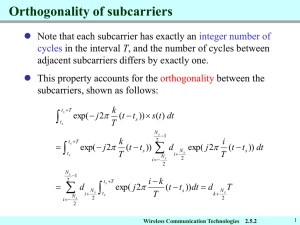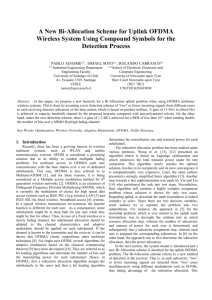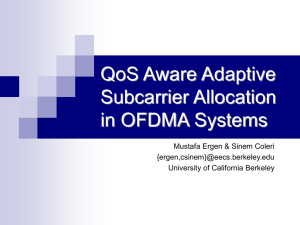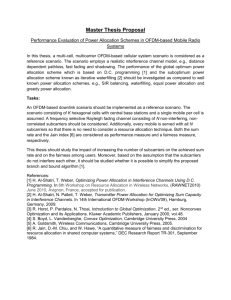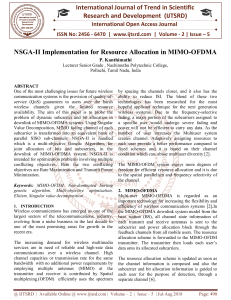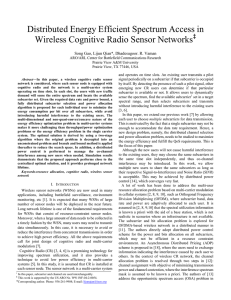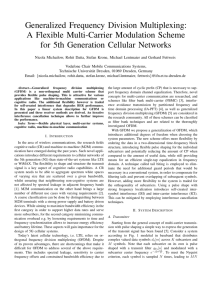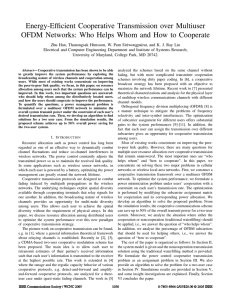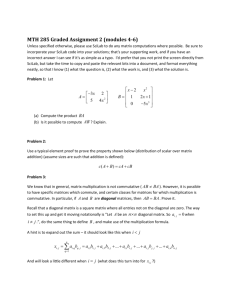pdf file
advertisement
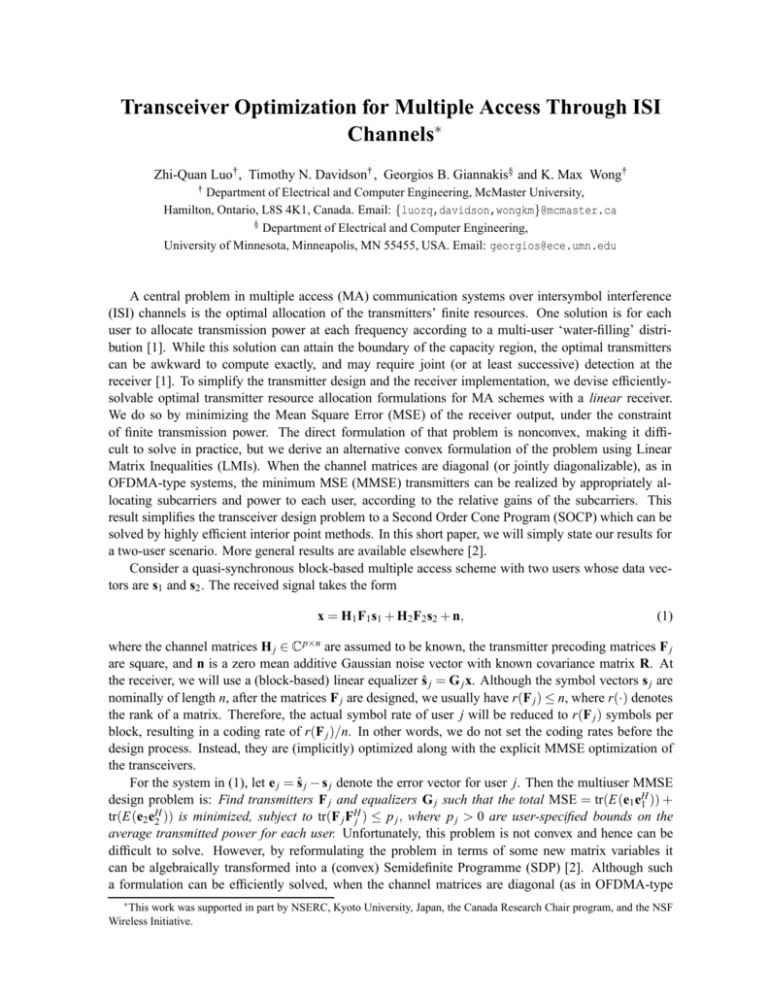
Transceiver Optimization for Multiple Access Through ISI
Channels∗
Zhi-Quan Luo† , Timothy N. Davidson† , Georgios B. Giannakis§ and K. Max Wong†
†
Department of Electrical and Computer Engineering, McMaster University,
Hamilton, Ontario, L8S 4K1, Canada. Email: {luozq,davidson,wongkm}@mcmaster.ca
§ Department of Electrical and Computer Engineering,
University of Minnesota, Minneapolis, MN 55455, USA. Email: georgios@ece.umn.edu
A central problem in multiple access (MA) communication systems over intersymbol interference
(ISI) channels is the optimal allocation of the transmitters’ finite resources. One solution is for each
user to allocate transmission power at each frequency according to a multi-user ‘water-filling’ distribution [1]. While this solution can attain the boundary of the capacity region, the optimal transmitters
can be awkward to compute exactly, and may require joint (or at least successive) detection at the
receiver [1]. To simplify the transmitter design and the receiver implementation, we devise efficientlysolvable optimal transmitter resource allocation formulations for MA schemes with a linear receiver.
We do so by minimizing the Mean Square Error (MSE) of the receiver output, under the constraint
of finite transmission power. The direct formulation of that problem is nonconvex, making it difficult to solve in practice, but we derive an alternative convex formulation of the problem using Linear
Matrix Inequalities (LMIs). When the channel matrices are diagonal (or jointly diagonalizable), as in
OFDMA-type systems, the minimum MSE (MMSE) transmitters can be realized by appropriately allocating subcarriers and power to each user, according to the relative gains of the subcarriers. This
result simplifies the transceiver design problem to a Second Order Cone Program (SOCP) which can be
solved by highly efficient interior point methods. In this short paper, we will simply state our results for
a two-user scenario. More general results are available elsewhere [2].
Consider a quasi-synchronous block-based multiple access scheme with two users whose data vectors are s1 and s2 . The received signal takes the form
x = H1 F1 s1 + H2 F2 s2 + n,
(1)
where the channel matrices H j ∈ C p×n are assumed to be known, the transmitter precoding matrices F j
are square, and n is a zero mean additive Gaussian noise vector with known covariance matrix R. At
the receiver, we will use a (block-based) linear equalizer ŝ j = G j x. Although the symbol vectors s j are
nominally of length n, after the matrices F j are designed, we usually have r(F j ) ≤ n, where r(·) denotes
the rank of a matrix. Therefore, the actual symbol rate of user j will be reduced to r(F j ) symbols per
block, resulting in a coding rate of r(F j )/n. In other words, we do not set the coding rates before the
design process. Instead, they are (implicitly) optimized along with the explicit MMSE optimization of
the transceivers.
For the system in (1), let e j = ŝ j − s j denote the error vector for user j. Then the multiuser MMSE
design problem is: Find transmitters F j and equalizers G j such that the total MSE = tr(E(e1 eH
1 )) +
H ) ≤ p , where p > 0 are user-specified bounds on the
tr(E(e2 eH
))
is
minimized,
subject
to
tr(F
F
j j
j
j
2
average transmitted power for each user. Unfortunately, this problem is not convex and hence can be
difficult to solve. However, by reformulating the problem in terms of some new matrix variables it
can be algebraically transformed into a (convex) Semidefinite Programme (SDP) [2]. Although such
a formulation can be efficiently solved, when the channel matrices are diagonal (as in OFDMA-type
∗ This
work was supported in part by NSERC, Kyoto University, Japan, the Canada Research Chair program, and the NSF
Wireless Initiative.
0.2
0.18
ρ2/|H j (i)|2;
u j (i)
0.16
0.14
0.12
0.1
0.08
0.06
0.04
0.02
0
0
5
10
15
20
25
30
Subcarrier index, i
Figure 1: A typical multiuser power allocation. The curves are linear interpolations of ρ2 /|H j (i)|2 for j = 1 (solid)
and j = 2 (dash-dot). The stems are of length u j (i) (where this is non-zero) for j = 1 (‘◦’) and j = 2 (‘×’).
systems) and R is also diagonal, the optimal transmitters are also diagonal [2] and can be computed
even more efficiently. (Diagonal transmitters simply represent power loading/subcarrier allocation and
hence they are easy to implement.) To state this formally, note that the diagonal elements of H j in an
OFDMA-type system are H j (i), where H j (i) is the frequency response of user j’s channel at frequency
ωi = 2π(i − 1)/n. If R = diag{ρ2i }, and we let u j (i) denote the power allocated by the jth user to the
ith subcarrier, and introduce an auxiliary vector w, the design problem becomes
n
minimizew,u1 ,u2
∑ ρ2i w(i)
i=1
n
subject to
∑ u1(i) ≤ p1 ,
n
∑ u2(i) ≤ p2 ,
u1 (i) ≥ 0, u2 (i) ≥ 0,
i=1
i=1
w(i) |H1 (i)|2 u1 (i) + |H2 (i)|2 u2 (i) + ρ2i ≥ 1.
(2)
There exist highly efficient (general purpose) implementations (e.g., [3]) of interior point solution
methods for the above (rotated) second order cone program with total computational complexity of
O(n3.5 log(1/ε)), where ε > 0 is the solution accuracy. Note that (2) depends only on the magnitude of
the subchannel gains, H j (i), and hence does not require phase estimation.
By examining the optimality conditions for (2) it can be shown [2] that in order to minimize the MSE
2
2
1 (i)|
1 ( j)|
one should allocate a subcarrier i to user 1 and a subcarrier j to user 2 only if |H
≥ |H
. In other
|H2 (i)|2
|H2 ( j)|2
words, the subcarriers are allocated to the users according to the relative ratios of the subchannel gains.
For all the subcarriers which are shared by both users, the subchannel gain ratio |H2 (i)|2 /|H1 (i)|2 must
be the same, and hence in a fading environment the probability of more than one subcarrier being shared
is vanishingly small. Of course, there may also be subcarriers which are not used by either user. These
subcarriers have small subchannel gain to (subcarrier) noise ratios for both users (i.e., both |H1 (i)|2 /ρ2i
and |H2 (i)|2 /ρ2i are small).
The results of the multi-user MMSE power loading algorithm for a typical scenario are shown in
Figure 1 in a form reminiscent of water-filling. (The signal-to-noise ratio is low to enhance clarity.)
Note that in this scenario, 19 subcarriers have been allocated to user 1 alone, 12 to user 2 alone, and
that subcarrier 25 is shared. Also note that subcarriers 5, 6 and 7 are allocated to user 2 even though
|H1 (i)| > |H2 (i)| for i = 5, 6, 7.
References
[1] R. S. Cheng and S. Verdú, “Gaussian Multiaccess Channels with ISI: Capacity Region and Multiuser WaterFilling”, IEEE Trans. Inform. Theory, vol. 39, pp. 773–785, May 1993.
[2] Z.-Q. Luo, T. N. Davidson, G. B. Giannakis and K. M. Wong, “Transceiver Optimization for Multiple Access
Through ISI Channels,” submitted to IEEE Trans. Inform. Theory, June 2001.
[3] J. F. Sturm, “Using SeDuMi 1.02, a MATLAB Toolbox for Optimization over Symmetric Cones,” Optim.
Meth. Software, vol. 11–12, pp. 625–653, 1999.

